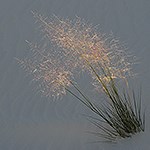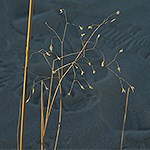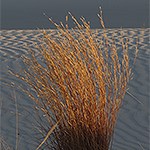|
Between the dunes in the interdunal areas of the park, grasses thrive. For plants like alkali sacaton, little bluestem, and Indian rice grass, survival depends on rapid growth, pollination, and reseeding at the far side of the interdunal space. Although an individual plant might perish, its offspring continue to succeed and colonize these areas.

NPS Photo Alkali Sacaton This widespread grass can be found in alkaline soils from Canada to Mexico, flourishing in poorly drained depressions where few other grasses can grow. Highly adaptive, it can withstand flooding and partial burial by the shifting sand. It has an important place in the ecosystem of the dunefield, where its seeds provide food for birds, rodents, and insects. 
NPS Photo Indian Ricegrass One of the earliest edible plants to mature in the spring, this hardy bunchgrass is an important part of the dunefield food web. The relatively large, protein-rich seeds are a major food source for birds, rodents, and other wildlife. For thousands of years, humans gathered the seeds along the edges of the dunes, drying and grinding the rice-like seeds into flour. 
NPS Photo Little Bluestem This prairie grass is named for the bluish-green color of its new growth. Dried stems turn a reddish-brown. Little bluestem grows throughout the Great Plains and Intermountain West, wherever soil moisture is adequate. So how can it grow in this desert landscape? At White Sands the water table is typically two to three feet below the surface, and the interdunal soils are usually quite moist. Learn more: Native Plants of the Northern Chihuahuan Desert |
Last updated: January 22, 2020
